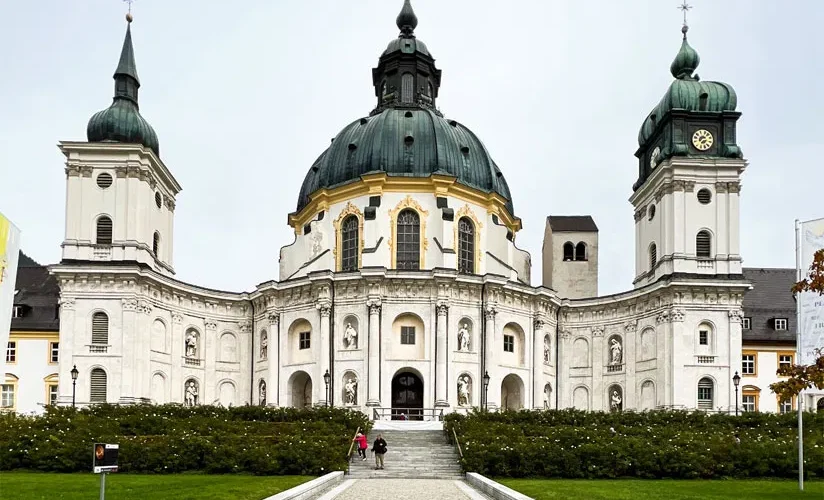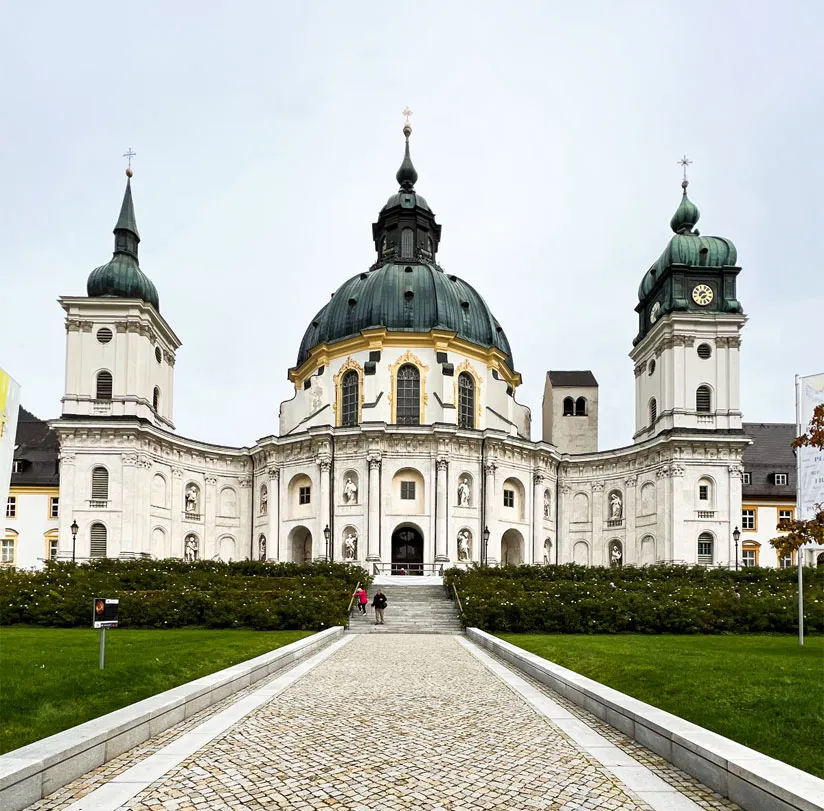
Introduction
Ettal Abbey (German: Kloster Ettal) is a Benedictine monastery in the village of Ettal close to Oberammergau and Garmisch-Partenkirchen in Bavaria, Germany. With a community (as of 2005) of more than 50 monks, with another five at Wechselburg, the Abbey is one of the largest Benedictine houses and is a major attraction for visitors.
At an altitude of 900 metres, situated between the Ammer and Loisach valleys, lies the famous Ettal Abbey – a Benedictine monastery founded in 1330 by Louis IV. Ettal is one of Bavaria’s architectural highlights with its striking and unique monastery grounds. The mighty Basilica, the magnificent Rococo vestry and treasures in the monastery library attract thousands of visitors each year. The monastery’s former royal apartment, the Dresdner room from the 18th century, is also worth visiting. It is named after the view of the river Elbe which flows through Dresden as it was seen in the 18th century. Or the Chinese Hall, a bright, light-flooded room that previously served as room for feasts and gatherings with ‘important guests’. Today, 30 monks live in the abbey under the rule of St. Benedict. The Benedictine school with boarding facilities and various businesses round off the Benedictine Ora et Labora (pray and work). Depending on their ranking, the monks of Ettal are able to earn a living as they wish. Guided tours of the monastery grounds are available upon prior arrangement.
Ettal Abbey is a working Benedictine monastery in Bavaria that has been an important religious and cultural site in Bavaria for over 700 years. The abbey was founded in 1330 by Emperor Ludwig the Bavarian. Its location in the foothills of the Alps made it an ideal place for a monastery, as it provided a peaceful and secluded environment for the monks to live and work. Over the centuries, the abbey has played an important role in the religious and cultural life of Bavaria. It has been a center of learning, with a renowned library and school. The abbey has also been a center of art, with its beautiful baroque church and other buildings.
The abbey has survived many challenges over the centuries, including wars, fires, and financial difficulties. Today, it remains an important cultural and religious site in Bavaria, attracting tourists from across the globe. In addition to its religious and cultural significance, the abbey is also an important economic driver in the region. It employs many people in the village of Ettal and supports local businesses.
Ettal Abbey, also known as Kloster Ettal, or the Ettal Monastery is a Benedictine monastery that was founded here in Ettal in 1330 by Louis IV, Holy Roman Emperor, as a gesture of gratitude for his victory in the Battle of Ampfing against the Habsburgs. The original purpose of the abbey was to provide a place of worship and refuge for both travelers and pilgrims. Ettal Abbey is one of the three main attractions, all concentrated on the German Alpine route. It is right on the road, a favorite tourist destination in Oberammergau with the Passion Play Theater and Linderhof Castle. The scenic location and the surrounding area make the small village a great holiday destination for those traveling from west to east along the Alpine Road, and Ettal is a good choice for hotel accommodation.
The monastery itself is not as old as some, it was founded in the 14th century by Emperor Ludwig (“Ludwig the Baier”). At that time, the pope was excommunicated in Italy due to the emperor’s military adventures. The legend of the foundation says that a “gray monk” appeared to the emperor when necessary and promised him safe passage to Bavaria if he respected the Virgin Mary in a place called “Ampferang.” When Ludwig promised to do so, the monk gave him the statue of Mary to place in the building. Returning safely to Bavaria, Ludwig asked one of today’s hunters in Garmisch-Partenkirchen if he knew the location. The hunter took him a few miles from Garmisch to the alpine forests, and in present-day Ettal his horse knelt three times in one place, signaling that this was the place where construction was to take place.
In fact, the monastery was a place of administration and study in the Middle Ages, and this location was much more likely to secure the southern edges of Ludwig’s rule and to control the trade route through the Alps. Be that as it may, the Benedictine monastery lasted for centuries and began to flourish in the 17th and 18th centuries as pilgrimages to the area increased. Many buildings burned down in the middle of the 18th century and the current appearance is in the Baroque style of that period. Like other Bavarian religious institutions, it was secular in the Napoleonic era. At the beginning of the 20th century, the Benedictine Order regained control of the buildings.
The current basilica buildings can be visited and the monastery is also known for its beer production and the various herbal liqueurs it produces. The second most popular attraction in Ettal is the Linderhof Palace, formerly owned by King Ludwig II of Bavaria. The village is remarkable for its picturesque nature, so hiking in the surrounding area is a great pleasure.
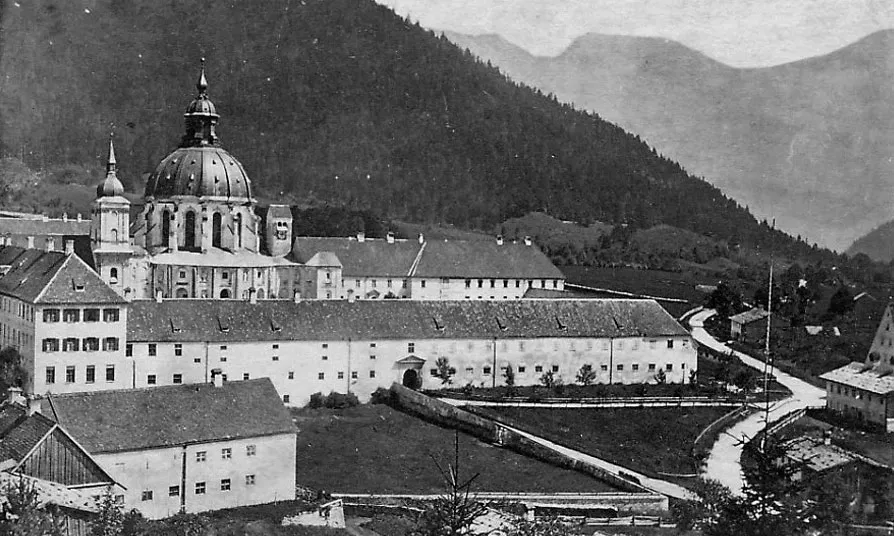
Ettal Abbey was founded on 28 April 1330, Saint Vitalis of Milan’s day, by Emperor Ludwig the Bavarian in the Graswang valley, in fulfilment of an vow, on his return from his coronation in Rome, on a site of strategic importance on the primary trade route between Italy and Augsburg. The foundation legend is that Ludwig’s horse genuflected three times on the site of the original church building, where a marble statuette of the Madonna and Child (“Frau Stifterin” or the “Ettal Madonna”) now stands. The statuette was brought by Ludwig from Pisa as a gift for his new foundation. It soon became an object of pilgrimage. The church is dedicated to the Assumption of the Blessed Virgin.
The foundation originally consisted of a Benedictine double monastery – a community for men and another for women – and also a house of the Teutonic Knights. The original Gothic abbey church, built between 1330 and 1370, was a modest structure in comparison to the great churches of medieval Bavaria. The abbey suffered great damage during the Reformation at the hands of the troops of Maurice of Saxony, but survived the troubles of the Thirty Years’ War (1618–1648).
Baroque expansion
In 1709, under Abbot Placidus II Seiz, the golden age of Ettal began with the establishment of the “Knights’ Academy” (“Ritterakademie”), which developed into a highly successful school and began the educational tradition of the abbey. In 1744, the abbey and the abbey church were largely destroyed in a fire. The subsequent spectacular re-building in the Baroque style, with a double-shelled dome, was to the plans of Enrico Zuccalli, a Swiss-Italian architect working in Munich, who had studied with Bernini. The decoration was primarily carried out by Josef Schmutzer of the Wessobrunn School of stuccoists and Johann Baptist Straub, who was responsible for the altars and the chancel. Ettal’s importance as a place of pilgrimage grew with the new buildings and it became one of the most important monasteries in the Alpine region.
Secularization
The abbey was dissolved in 1803 during the secularization of church property in Bavaria. The site was acquired in 1809 by Josef von Elbing and sold by his descendants in 1856 to Count Pappenheim. Some small building works were completed during the 19th century, principally the renovation of the façade and the twin bell towers.
Second foundation
In 1898, the buildings were acquired by Baron Theodor von Cramer-Klett and, in 1900, given to the Benedictines of Scheyern Abbey, who re-founded the monastery here. It has been a member of the Bavarian Congregation of the Benedictine Confederation since 1900. The abbey church of the Ascension was declared a basilica minor in 1920.
During the winter of 1940–1941, the German pastor and theologian Dietrich Bonhoeffer (1906–1945) spent some months at the monastery as the friend and guest of the Abbot. Like Bonhoeffer, a number of those in the Ettal community were involved in the conspiracy against Hitler. While at Ettal, Bonhoeffer also worked on his book Ethics. Catholic priest Rupert Mayer was kept at the Abbey under house arrest from 1939 to 1945 by the Nazis to prevent him from further anti-Nazi preaching.
In 1993, Ettal re-founded the former Wechselburg Abbey in Saxony, an old monastery of the Augustinian Canons, as a Benedictine priory. Ettal maintains a Byzantine Institute. The abbot of Ettal, Joannes Hoeck, made a significant contribution on the role of Patriarchs in Church government at the Second Vatican Council.
Evolution Over the Centuries
Over the centuries, Ettal Abbey has undergone significant changes and expansions. In the 18th century, the abbey was rebuilt in the Baroque style by Johann Jakob Herkomer. The church was expanded and adorned with frescoes, stucco work, and sculptures. The abbey also became a center for education, with a school and library established.
The War Years
During World War II, Ettal Abbey was used as a military hospital by the German army and after the war, the abbey was restored and reopened to the public. Today, Ettal Abbey is still an active Benedictine monastery, with about 50 monks living and working on the premises. Visitors can tour the abbey church, library, and museum, as well as purchase products made by the monks, such as beer, wine, liqueur, and even cheese.
Architecture of Ettal Abbey Monastery Germany
Ettal Abbey showcases stunning Baroque architecture characterized by extravagant decoration, ornate details, and grandiose proportions. The elegant facade and intricate interior design will leave you in awe of the craftsmanship displayed throughout the abbey.
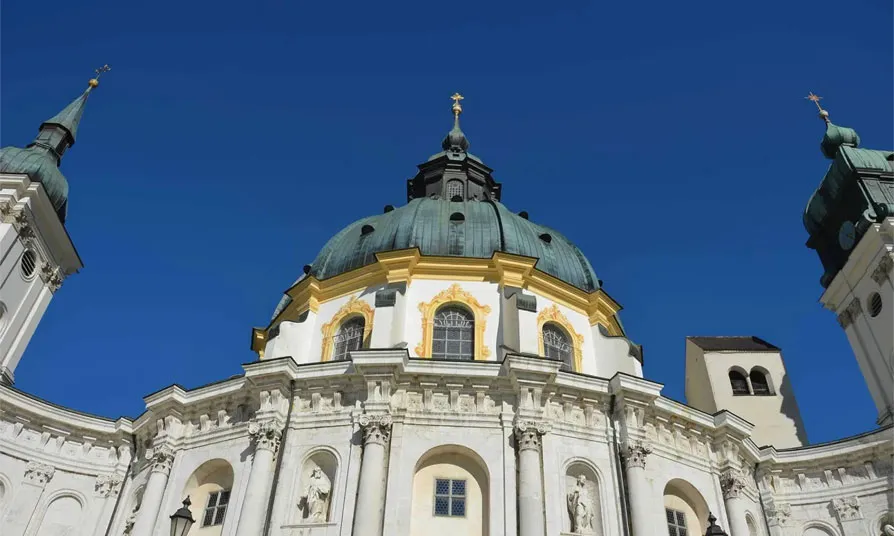
The Mighty Basilica
Ettal Abbey’s Basilica is an impressive example of Baroque architecture. The basilica’s interior is adorned with intricate frescoes and stucco work, and the high altar is made of white marble. The basilica’s dome is a prominent feature of the structure and is supported by four massive pillars.Visitors can also admire the beautiful stained glass windows that depict scenes from the Bible.
The Magnificent Rococo Vestry
The Vestry of Ettal Abbey is a stunning example of Rococo architecture. The walls are adorned with intricate stucco work and frescoes, and the ceiling is decorated with a beautiful painting of the Holy Spirit. The vestry is also home to a collection of valuable liturgical objects, including chalices, ciboriums, and monstrances.
Unique Monastery Grounds
The monastery grounds of Ettal Abbey are a unique blend of Baroque and Rococo architecture. Visitors can explore the monastery’s cloisters, which are adorned with frescoes and stucco work. The monastery also features a beautiful garden, which is home to a variety of plants and flowers.Visitors can relax and enjoy the peaceful surroundings while taking in the beauty of the abbey’s architecture and the surrounding mountains.
The Monastery Library
Ettal Abbey is home to a magnificent library that houses over 150,000 volumes of books, manuscripts, and other important documents. The library is located on the first floor of the monastery and is open to visitors for guided tours.
Treasures and Significant Manuscripts
The library’s collection includes many significant manuscripts and books dating back to the medieval period. Here you can view the original handwritten manuscripts of famous composers such as Mozart and Beethoven. The library also has a collection of rare books, including first editions of works by famous authors such as Goethe and Schiller. One of the most significant manuscripts in the collection is the Codex Aureus of Echternach, a gospel book from the 11th century that is adorned with gold and precious stones. The library also has a collection of illuminated manuscripts, including the famous Book of Hours.
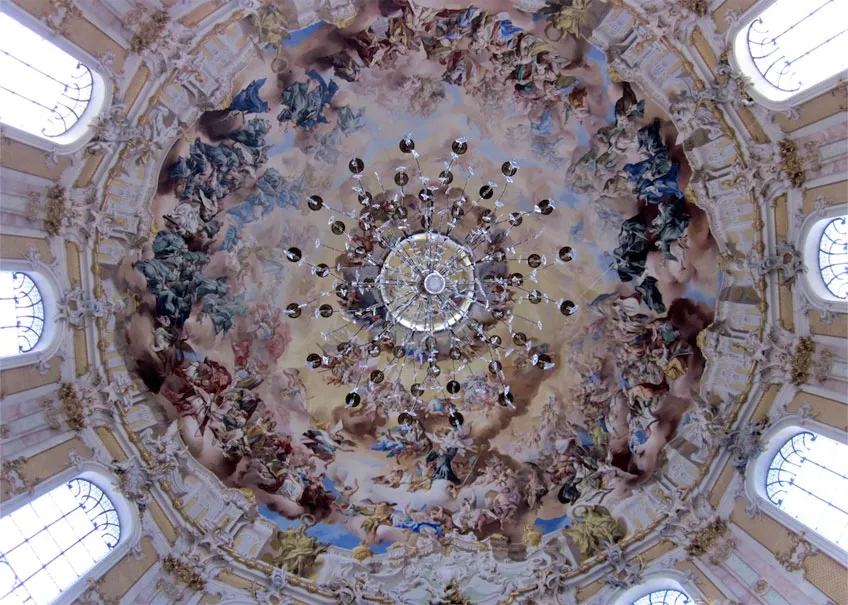
Importance to Bavaria’s Cultural Heritage
The library at Ettal Abbey is an important part of Bavaria’s cultural heritage. It is considered one of the most important monastic libraries in Germany and has been designated as a cultural monument by the Bavarian government. The library’s collection is a testament to the importance of preserving cultural heritage. It contains works that have been carefully preserved for centuries and serves as a reminder of the importance of preserving knowledge and art for future generations.
Ettaler Klosterbiere (Ettal Brewery)
Ettal Abbey is home to a brewery that produces some of the finest beers in the region. The Ettaler Klosterbiere has been in operation since the 1600s and is known for its unique brewing techniques and high-quality ingredients. The brewery produces a range of beers, including lagers, ales, and wheat beers. The most popular beer is the Ettaler Kloster Dunkel, a dark lager with a rich, malty flavor. Other popular beers include the Ettaler Kloster Helles, a light lager, and the Ettaler Kloster Weizen, a wheat beer.
There are tours of the brewery available where you’ll be educated about the entire brewing process. The tour includes a visit to the brewery’s museum, where visitors can see historic brewing equipment and learn about the history of the brewery and beer. In addition to the brewery tour, visitors can also enjoy a beer tasting at the abbey’s beer garden. The beer garden is a popular spot for locals and tourists alike, and offers a relaxed atmosphere to enjoy a cold beer and some traditional Bavarian food. Overall, the Ettaler Klosterbiere is a must-visit for beer lovers visiting Ettal Abbey. With its rich history, unique brewing techniques, and high-quality ingredients, it’s no surprise that the brewery has become a beloved institution in the region.
Ettal Basilica
The Ettal Basilica began as a modest Gothic Church built between 1330 and 1370, the church destroyed by fire in 1744. Re-building took place in the more decorative Baroque style, with many construction changes occurring in later years. The Basilica has a richly decorated interior, mostly in Baroque style with touches of Rococo, it has gilding, stucco and wonderful ceiling frescoes. Respected artists of the time Johann Jakob Zeiller, painted the ceiling fresco, and Martin Knoller the choir and main altar painting. The Basilica has six side altars with statues of various saints including Saint Magnus, who is the saint relevant to the founding of the Abbey in Fussen .
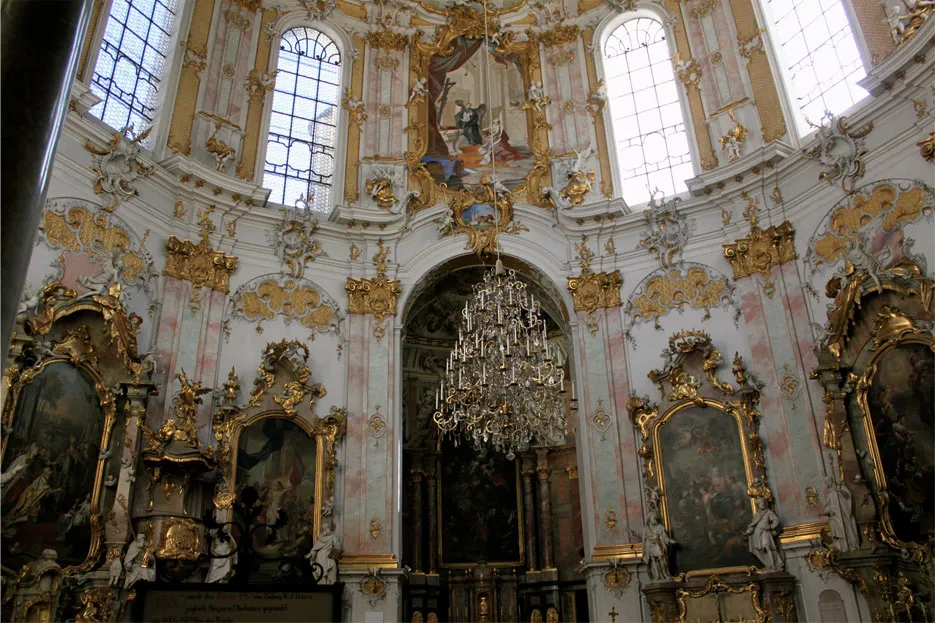
The Benedictine Monks of Ettal Monastery
Daily Life and Routines
The Benedictine Monks of Ettal Monastery follow a strict daily routine that revolves around prayer, work, and community life. They wake up early in the morning, usually around 5:00 am, to attend the first prayer of the day, known as Vigils. This is followed by Lauds, Mass, and breakfast. After breakfast, the monks engage in manual labor, which includes farming, brewing beer, and carpentry. The monks also dedicate a significant amount of time to studying and reading, which is an essential part of their spiritual and intellectual growth. They also observe strict silence during certain times of the day, such as during meals or when they are working which allows them to focus on their spiritual practices and cultivate a deeper sense of inner peace.
Their Role in Maintaining the Abbey and Its Traditions
The Benedictine Monks of Ettal Monastery play a crucial role in maintaining the abbey and its traditions. They are responsible for the upkeep of the buildings, gardens, and grounds, as well as the production of various goods, such as beer, cheese, and honey. The monks also serve as spiritual leaders and mentors to the local community and visitors. They offer retreats, spiritual guidance, and counseling services to those seeking a deeper understanding of their faith. In addition to their spiritual and practical duties, the monks also participate in various cultural and social events, such as concerts, lectures, and festivals. These events help to promote the abbey’s mission of fostering a sense of community and cultural exchange.
Ettal Abbey’s Role in Modern Bavaria Today
Housing and Support for Refugees
Ettal Abbey has played an important role in providing housing and support for refugees in modern Bavaria. In 2014, the abbey opened its doors to Ukrainian refugees who were fleeing conflict in their home country. The abbey provided temporary housing and support for these refugees as they adjusted to their new lives in Germany. The abbey’s efforts to support refugees have continued in the years since. In 2015, the abbey provided housing for Syrian refugees who were seeking asylum in Germany. The abbey also offers language classes and other support services to refugees who are living in the area.
Educational Endeavors: School Buildings and Their Significance
The Abbey has a long history of educational endeavors, and this tradition continues today. The abbey operates a boarding school for boys, which has been in operation since the 16th century. The school provides a rigorous academic program, as well as opportunities for students to participate in sports and other extracurricular activities. In addition to the boarding school, the abbey also operates a vocational school, which offers training in a variety of trades. The vocational school has a strong reputation for producing skilled workers who are in high demand in the local economy.
The school buildings themselves are also significant. The abbey’s Baroque-style buildings are considered to be some of the finest examples of this architectural style in Bavaria. The buildings have been well-preserved over the centuries, and they continue to be an important part of the abbey’s educational mission. Overall, Ettal Abbey’s role in modern Bavaria is multifaceted, encompassing both its historical significance and its ongoing efforts to support refugees and provide educational opportunities for young people.
Classical concerts in Ettal Monastery
The features of note of the church are its three retablos of carved limestone which were formerly polychromed, the carved pediment which featured the folk portrayal of the Spanish winning over the Moors at the Battle near Tétouan, Morocco as well as its adjacent sprawling ruins where an oven well and kilin for baking can be found.
Annual Feast Day
Feast day: 28 September
The feast date of Ettal Abbey in Germany is celebrated on September 28th. This feast day is in honor of St. Wenceslaus, who is the patron saint of Ettal Abbey.
Mass Timing
Monday to Saturday: 9.30 a.m. to 4.30 p.m.
Sundays and public holidays: 1.30 p.m. to 4.30 p.m.
Contact Info
Benedictine Abbey of Ettal ,
Kaiser-Ludwig-Platz 1,
D-82488 Ettal,
Germany.
Phone No.
Tel :+49 08822 740
Accommodations
Connectivities
Airway
The nearest airport to The Church of Ettal Abbey Monastery Germany is, Deltaplan landing area Oberammergau, 82487 Oberammergau, Germany, which is just 9 min (5.7 km) via B23 away from the basilica.
Railway
The nearest railway to The Church of Ettal Abbey Monastery Germany, Garmisch-Partenkirchen, Bahnhofstraße 31, 82467 Garmisch-Partenkirchen, Germany, which is just 20 min (14.9 km) via B23 and B2 away from the basilica.

